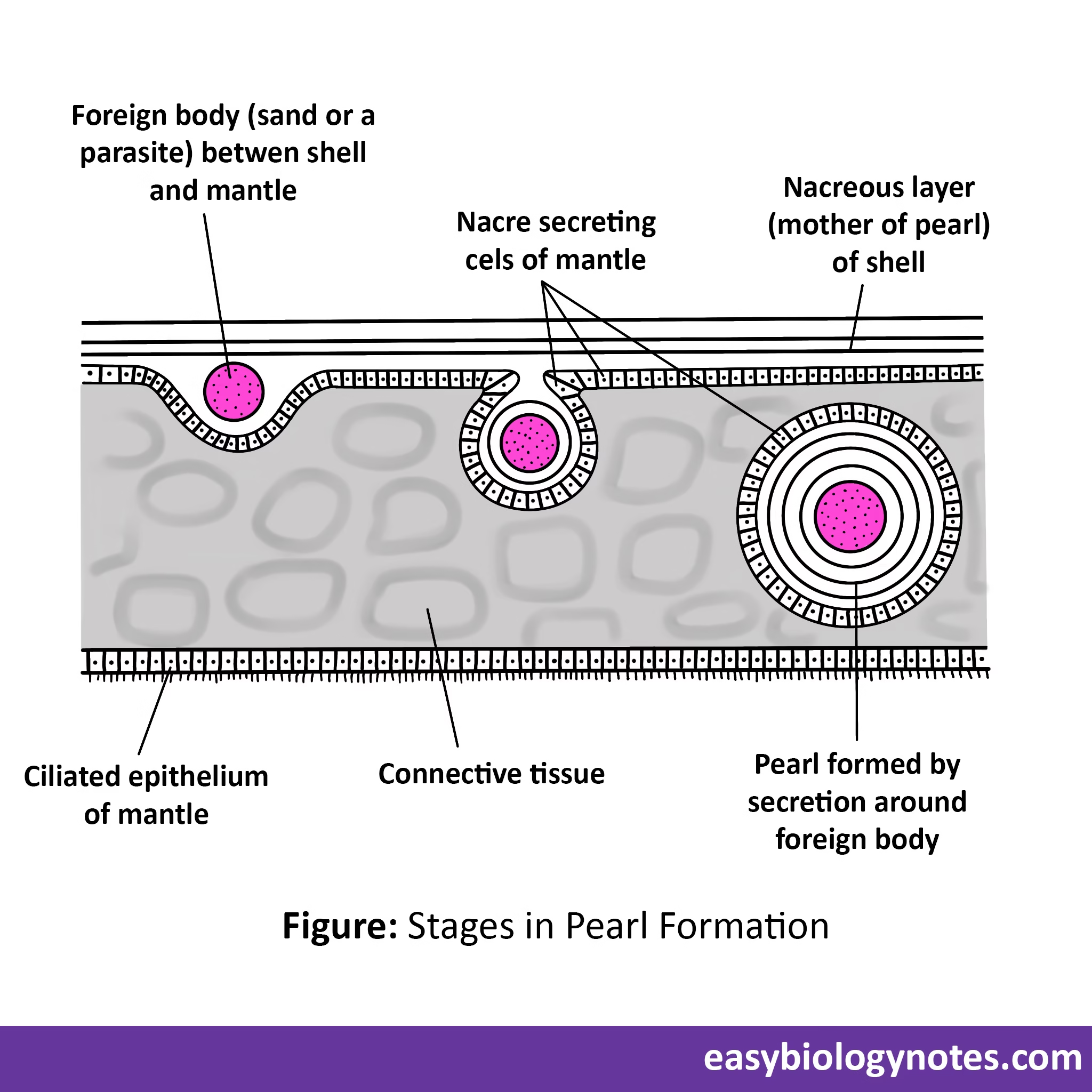How does Pearl Formation in Mollusca take place?
The “pearl” is literally formed by the mantle epithelium which becomes deposited around any external body or particles; these external particles or body invade in between the shell and mantle in any way.
Pearl is secreted by the mantle as a means of protection against a small external particle. When an external particle or body, such as a grain of sand or a small parasite, invades in between the mantle and the shell, it becomes enclosed in a sac of mantle epithelium which produces irritation. The irritation stimulates the mantle epithelium to secrete thin concentric layers of mother of pearl around the foreign body. The amount of deposition is in direct proportion to the degree of irritation. After several years, a pearl will be formed; usually, it requires 3 to 4 years to produce a pearl of considerable size, but a large pearl requires about 7 years.
The foreign particles in the pearl are called the nucleus, whereas the thin nacre layers are concentric and called the mother of pearl.

Types of Pearls
- Linga pearls
- Seed pearls
- Button pearls
- Blister pearls
1. Linga Pearls
- These are elongated, cylindrical pearls that form primarily in freshwater mussels
- Their distinctive shape results from their formation along the mantle tissue near the hinge ligament of the mollusk
- They typically show good luster due to consistent nacre deposition in this protected area of the mollusk
- The formation process is often influenced by the natural contours of the mollusk’s mantle tissue in this region
2. Seed Pearls
- These are very small pearls, typically measuring less than 2mm in diameter
- They form naturally in both saltwater and freshwater mollusks, particularly oysters and mussels
- Formation occurs when minute irritants enter the mollusk, triggering the nacre-secreting response
- Their small size results from a shorter period of nacre deposition or smaller initial irritant
- Historically significant in traditional medicine and decorative arts, especially in Asian cultures
3. Button Pearls
- Characterized by a flattened or dome-shaped appearance on one side
- Form when pearls develop against the inner shell surface of the mollusk
- The flattened side results from the pearl sac’s contact with the shell during formation
- Common in both natural and cultured pearl production
- The nacre layers are typically more concentrated on the domed side
4. Blister Pearls
- These are pearls that form attached to the inner shell surface of the mollusk
- They develop when an irritant becomes trapped between the mantle and shell
- Unlike free pearls, they remain partially attached to the shell
- The exposed surface is covered with nacre, while the attached side remains flat
- Often irregular in shape due to their formation process
- Can be carefully removed from the shell but require special processing
Significance of Pearls
Throughout the centuries, pearls have been associated with wealth, femininity, purity, wisdom, patience, and peace. Due to their appearance, they have often been compared to the moon and are said to have a calming, protective, and strengthening effect on the wearer.
These days, pearls are still regarded as beautiful and feminine gemstones.
Commercial Importance of Pearls
- Pearls and pearl-oyster shells have long been used as jewellery items by humans.
- However, these are not their sole uses:
- The adductor muscle can be eaten and is used in cuisine in a number of different regions.
- The shell itself is often worked into simple jewellery or more complex furniture and other decorative items.
- The pearl-oyster shell is increasingly used for its health benefits. Its powder contains about 17 amino acids and many mineral elements and can be used as nutrient and medicine, which is useful in treating various health problems such as heart disease, sore throat, heartburn, eye diseases, etc. It is also used as a vital content of skin protection creams.
- Historically, the largest need for the pearl resource is for mother of pearl (MOP), also called nacre. This shell material is used for making buttons, and this aided the emergence of important shell-collecting industries in Mexico, Australia, French Polynesia.